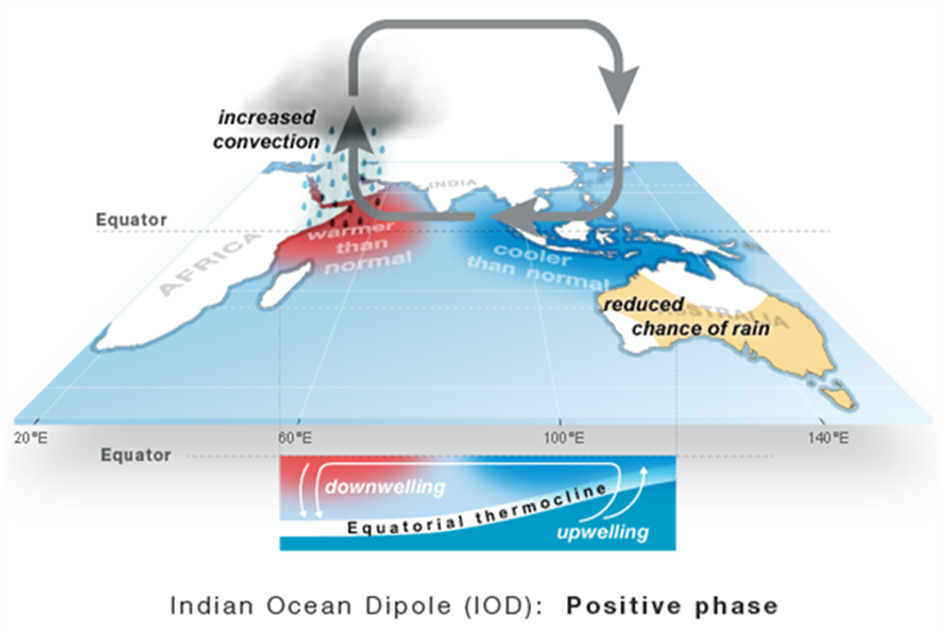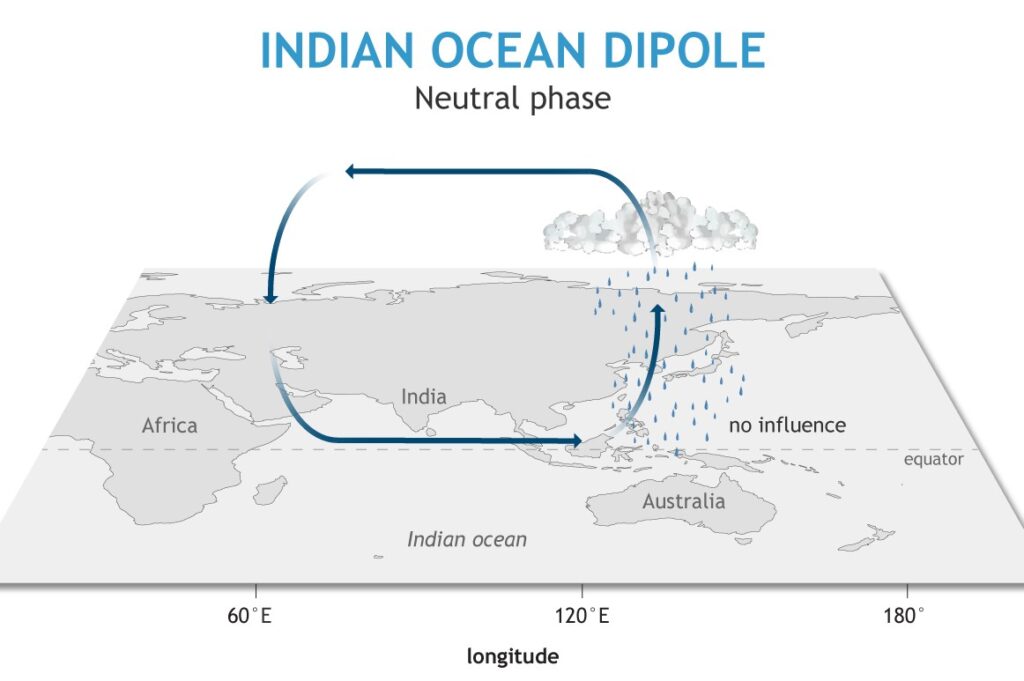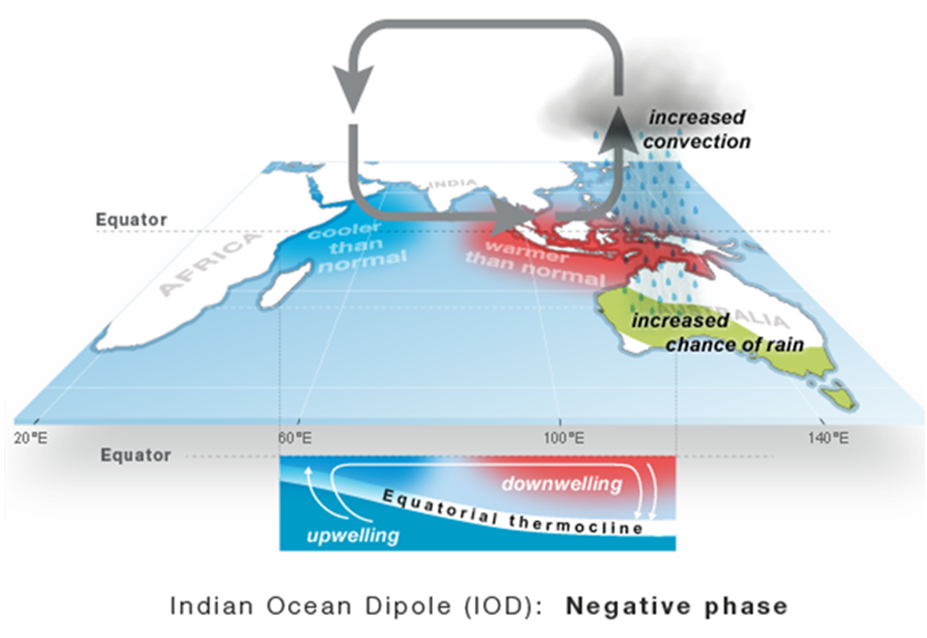Indian Ocean Dipole (IOD) is an atmosphere-ocean coupled phenomenon in the tropical Indian Ocean (like the El Nino is in the tropical Pacific), characterised by a difference in sea-surface temperatures.
Phases of IOD
IOD has three phases: Positive phase , Neutral phase and Negative phase.
Positive phase of the IOD
A ‘positive IOD’ — or simply ‘IOD’ — is associated with cooler than normal sea-surface temperatures in the eastern equatorial Indian Ocean near Java and Sumatra accompany warmer than normal sea-surface temperatures in the western tropical Indian Ocean.

The east-west contrast in ocean conditions (a “dipole”) alters the wind, temperature, and rainfall patterns in the region, typically bringing floods to eastern Africa and droughts and bushfires to eastern Asia and Australia, among other ecological and socio-economic impacts.
A ‘positive IOD’ typically peaks in September–November.
Neutral phase of the IOD
The neutral phase of the Indian Ocean Dipole shows neither positive nor negative features.

Negative phase of the IOD
It is characterised by warmer than normal sea-surface temperatures in the eastern equatorial Indian Ocean and cooler than normal SSTs in the western tropical Indian Ocean.

During negative phase of the IOD Indonesia and Australia tend to be wetter than normal, while eastern Africa tends to be drier than normal.
Dipole Mode Index
The strength of the IOD is monitored with the Dipole Mode Index, which is a measure of the surface temperature difference between the western and eastern tropical Indian Ocean.
Impact of IOD on southwest monsoon in India
Types of IOD in context of monsoonal rainfall in India
There are three types of IOD: normal IOD, early IOD and prolonged IOD.
An early IOD, which peaks in the mid-monsoon months (July and August), plays a significant role in enhancing monsoon rainfall even though its intensity is medium compared to other IODs. The normal IOD and prolonged IOD peak in September, October, November and hence play a lesser role in the monsoon rainfall.
A positive IOD leads to greater monsoon rainfall and more active (above normal rainfall) monsoon days while negative IOD leads to less rainfall and more monsoon break days (no rainfall).
Why early IOD enhances monsoon rainfall?
During an early IOD, the combined effect of Arabian sea evaporation and stronger cross equatorial flow — winds blowing from the southern tropics to the north across the equator — play an important role in enhancing the monsoon activity over the Indian subcontinent. Also, there are fewer breaks in monsoon conditions during early IOD events.
Combined effect of El Nino and positive IOD on monsoon rainfall
The effect of El Nino in general is to decrease the monsoon rainfall over the Indian subcontinent. The IOD on the other hand increases the monsoon activity over India.
During weak El Nino years (1994 and 2006) there were no break events in the peak monsoon months of July and August (early IOD), whereas in the case of moderate (1987), strong (1972) and very strong El Nino years (1982, 1997) more break events were observed during the mid-monsoon months.
Connection between ENSO and the IOD
There is a close connection between ENSO and the IOD, as ENSO is one of the main triggers of IOD events.
During El Niño, the anomalous (departure from average) surface winds near Indonesia blow from southeast to northwest, helping to bring cold water to the surface near Java and Sumatra and initiating a positive IOD event . Similarly, La Niña tends to trigger negative IOD events.
Does human-caused climate change have any effect on the IOD?
A recent study argues that extreme positive IOD events, will occur almost three times as often in the 21st century relative to the 20th century.
That means we would experience an extreme positive IOD event about once every 6 years in this century, potentially bringing more frequent floods, droughts, and bushfires.
PRACTICE QUESTIONS
QUES – With reference to ‘Indian Ocean Dipole (IOD)’ sometimes mentioned in the news while forecasting Indian monsoon, which of the following statements is/are correct? UPSC 2017
1 . IOD phenomenon is characterized by a difference in sea surface temperature between tropical Western Indian Ocean and tropical Eastern Pacific Ocean.
2 . An IOD phenomenon can influence an El Nino’s impact on the monsoon.
Select the correct answer using the code given below:
(a) 1 only
(b) 2 only
(c) Both 1 and 2
(d) Neither 1 nor 2
(b)
